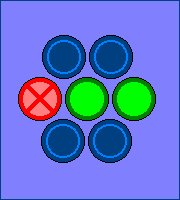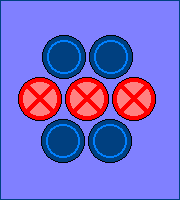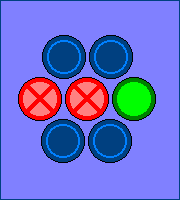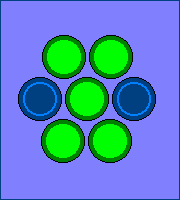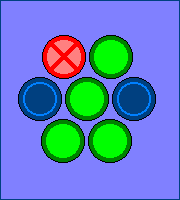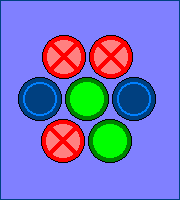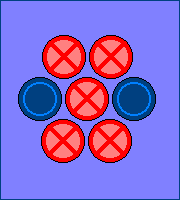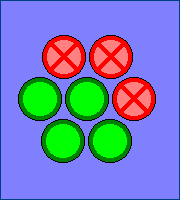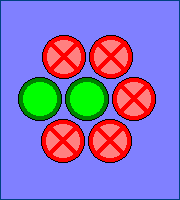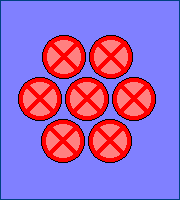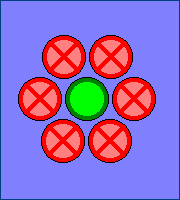This is our champion, John Doe.
In two days, he has won $14,650.
Today, he will take on one of these three challengers:
Jane Smith, Don Miller, and Susan Johnson.
They will try to dethrone our champ for a chance at $10,000!
AND THEY'LL DO IT, IF THEY DON'T...

OBJECTIVE: Four players compete. Use knowledge and strategy to eliminate your opponents by striking them out, while avoiding a Strikeout yourself.
ROUND 1
|
|
In the first round, three new players compete for the opportunity to face the champion from the previous day. All challengers begin the game with a limit of three Strikes, which will be used up along the way for wrong answers or unsuccessful challenges. The podiums on the right are an example of how the players' scores would look at the beginning.
|
|
|
In the first round, the players are asked up to 10 general knowledge questions. Each question has 3 choices, one of which being the correct answer. After the question is read, each player locks in which choice they believe to be the correct answer. They have 3 seconds to pick one, and if they don't, it's ruled a pass. A correct answer wins $100, a wrong answer gives the player a Strike. Players may pass on any number of questions without penalty. If one player guessed right, another guessed wrong, and the third contestant passed, the scores would look like the example on the right.
|
|
|
Round 1 continues until one player accumulates three Strikes. That player is out of the game, and the two remaining contestants advance to the second round. If all 10 questions are asked and nobody Strikes Out, or if two or more people Strikeout on the same question, the player(s) with the most money advance. If there's a tie for score, a sudden-death question is asked. The fastest person to lock in a correct answer, or the slowest person to lock in the wrong answer, goes on.
|
|
|
ROUND 2
|
|
After the first round, both contestants' Strike limits are increased to five. All Strikes earned in the first round are still retained, though. In the second round, one player will be read the category to a question, and then has the option of either answering the question him/herself, or challenging his/her opponent to answer it. The contestant with the fewest Strikes after the first round (or the one with the most money if there's a tie) controls the first question, and control alternates thereafter.
|
|
A correct answer in the second round earns $250. Like the first round, an incorrect answer counts as a Strike. In the event of a challenge, both the money and the Strike are in play (meaning if you challenge and the other player misses, you get the money; but if you challenge and your opponent gets it right, you get the Strike). In the example to the right, the first player missed a question, then succeeded in answering a question passed to him, netting Player 1 another $250 and giving both players another Strike.
|
|
The round continues until either 10 questions are asked or one player picks up a total of five Strikes from the first two rounds. The player remaining wins the round and faces the champion in Round 3. If, after 10 questions, nobody has Struck Out, one final sudden death question is asked. In the example on the right, the second player has fallen to the first after a tough battle.
|
ROUND 3
|
|
In the third round, the champion from the previous game finally enters the ring to defend his/her title against the winning challenger. The challenger's limit is again extended to seven Strikes, while the champion begins the game with a limit of five Strikes. Although this may seem to favor the challenger, remember that Strikes earned in the first two rounds still carry over, so if the challenger has amassed more than 2 Strikes earlier in the game, it gives the champion an advantage.
|
|
The rules to Round 3 are very similar to those of Round 2. Beginning with the challenger, one player is read the category to a question, who can then play it or pass it to his/her opponent. In this round, however, no money is at stake with these questions, only Strikes. Like before, a wrong answer gives that player a Strike, while a right answer gives a Strike to the other player. If the challenger misses one of two questions, and the champion gets his first question right, the score would look like the example on the left.
|
|
The first player to reach his/her limit of Strikes, be it 5 or 7, is eliminated. The last remaining player is crowned champion. s/he wins another $1,000 and advances to the Bonus Round, to try and "Go the Distance" for $10,000. In the example on the right, it appears as if our champion has defeated yet another opponent.
|
|
|
BONUS ROUND: "Go the Distance"
In the final round, the champion goes it alone. Yet again, the limit of Strikes the player has to work with goes up by two, giving new champions a total of 9 Strikes to burn, while returning champs get 7. The contestant is offered three categories from which his/her questions will originate for the entirety of the round. To the left, we see today's winner prepare to Go the Distance. (That money amount is his total for three days.)
|
|
The bonus round consists of six questions, each with two-part answers. In order to get through the question unscathed, the player must give both answers. Otherwise, he/she earns one Strike for each right answer that was missed. (So blowing the question gives the player two Strikes). The contestant also picks up $200 for each question he/she can get through before Striking Out.
|
|
If the contestant can Go the Distance and make it through all six questions without Striking Out, he/she wins $10,000. (Like our champion has just done.) Champions remain on the show as long as they keep winning; there is no such thing as retiring undefeated. When a champion manages to win five straight games, he/she wins $10,000 automatically in place of the $1000 for a front game win, and attempts to Go the Distance for a new car.
|
BIG MONEY STRIKEOUT!
If the show were to become a prime-time, high-stakes quiz, the payoffs would be inflated as such:
- $500 for every correct answer in Round 1
- $1000 for every correct answer or successful challenge in Round 2
- $10,000 for winning Round 3
- $2,000 for each question in the bonus round, $50,000 for Going the Distance
- 5-time champs win $50,000 automatically and attempt to Go the Distance for $1,000,000
THE EVOLUTION OF STRIKEOUT!
Strikeout! really emerged out of another idea I was contemplating in high school. Fresh off of watching the California lottery show "The Big Spin" and their new game at the time called "Wizard of Odds", I felt inspired to create a show that involved crystal balls. The memories are sketchy, but I remember the important part: on a correct answer, the player's crystal ball would turn green; if incorrect, it turned red. I quickly dropped the crystal balls and replaced them with Strikes, and the format really started working out.
In the summer of '99, however, something occurred that had me running for the drawing board again. As all of us game show fans can tell you, this was the time that Who Wants to be a Millionaire premiered. It's a great show, but it did seem to have a format similar to my original bonus round (which required players to get through 12 questions before Striking Out). I had to change the endgame somewhat to get rid of the similarities.
One more thing - if you're a fan of game shows from abroad, you may think that this concept is an adaptation of the British show Fifteen to One. Believe me, I had absolutely no idea that such a show existed - it wasn't until I posted my original proposal on A.T.G-S that a Brit by the name of Chris Dickson brought thatt to my attention. Hopefully there are enough differences between my idea and theirs (for instance, Fifteen to One doesn't have a bonus round, the contestants don't get more chances as the game progresses, and there is no returning champion) will save me from getting slapped with a lawsuit.
WHO WOULD I HIRE?
(If I couldn't pick myself)
Host: I'd need someone who's good at high-energy games, but also a good question reader. Believe it or not, but I'd say Kenny Mayne would be a nice fit for the show (although I do want to avoid the sports analogies if possible). Marc Summers would also work.
Announcer: I don't know if he's still in the business, but Don Morrow had a great, stentorian voice. It'd be a nice compliment to the atmosphere. If he isn't, Charlie O'Donnell has a similar delivery.
Set: The main color will be blue. Black, glossy floor with the logo on it. I'd like to see a line of chasing lights in the same fashion as the Strike lights on the podiums running down the center of the wall (think Bullseye). Challenger podiums will be camera right, Champion's/GtD podium camera left. The host has no podium; he stands at center stage for the first round, then close in on the challenger podiums for rounds 2 and 3.
SELLING POINTS
The strategy is the key element in this game. While the first round is a simple test of knowledge, the other two rounds in the front game involve metering your opponent's strengths and weaknesses. After all, what good is challenging your foe to answer a Science question if he's a chemistry professor at UCLA? The drama also picks up if one player is down six strikes to two in the third round, and starts pulling off a comeback. Keeping a champion on the show until he loses will promote a sense of continuity. Remember back in 1980, Tic Tac Dough was struggling in the ratings until a man by the name of Thom McKee starting racking up win after win.
WEAKNESSES
I kind of alluded to this when recommending a host, but I really don't want this show to get caught up in sports jargon. I mean, yes, the strikeout is one of the oft-referred to terms in the sports world, but if the show gets saddled with "Home Runs" and "Double Plays" and whatnot, I'm afraid the show will turn into a caricature, and it's supposed to be a hard quiz.
FRUITION RATING (1-10): 10
So when can I pitch this thing, anyway? (Did I say Pitch?)
LOOGAROO PRODUCTION PRIORITY: 1st
This should be the trademark show for Loogaroo Productions.
Questions, comments, cares or concerns? Use the link on the left to E-mail me and tell me what you think!
Back to the Game Show Lair










